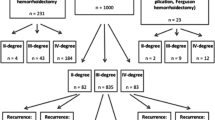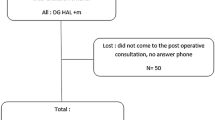Abstract
Purpose
We describe the arterial detection ligation (ADL) technique, designed to find arteries at time-appropriate depth for ligating, and report our preliminary results of using this technique to treat patients with the hemorrhoidal disease (HD).
Methods
The subjects of this retrospective analysis were patients with symptomatic grades 2 or 3 HD. We analyzed the clinical characteristics, postoperative complications, recurrence, and patient satisfaction of the patients treated with ADL.
Results
A total of 75 patients were included in the study (male/female ratio 1.88; mean age 48 ± 19 years; mean BMI 24 ± 3 kg/m2). Thirty-nine patients (52%) did not require hospitalization and were discharged from the day clinic approximately 4 h postoperatively. Four patients (5.3%) suffered tenesmus for about 1 week postoperatively and two (2.7%) suffered temporary rectal bleeding. The mean VAS scores 1 day postoperatively, then at 1 week, 1 month and 1 year were 2.9, 1.5, 0.4, and 0, respectively. At the 1-month follow-up, there was no sign of recurrence and the satisfaction rate was 78.6% (n = 59). At the 1-year follow-up, three patients (4%) had a recurrence and the satisfaction rate was 86.7% (n = 65).
Conclusion
Based on our preliminary findings, ADL is an effective technique for treating HD, generally as an outpatient procedure, without serious morbidity. We anticipate that the incidence of tenesmus, which is encountered frequently after other dearterialization methods, will be lower after the ADL technique, which avoids both mass ligation of hemorrhoidal arteries deeper than 12 mm and running a long mucopexy suture line.




Similar content being viewed by others
Abbreviations
- HD:
-
Hemorrhoidal disease
- DGHAL:
-
Doppler-guided hemorrhoidal artery ligation
- SRA:
-
Superior rectal artery
- ADL:
-
Arterial Detection Ligation
- BMI:
-
Body mass index
- ASA:
-
American Society of Anesthesiologists
- VAS:
-
Visual Analogue Scale
References
Kaidar-Person O, Person B, Wexner SD. Hemorrhoidal disease: a comprehensive review. J Am Coll Surg. 2007;204:102–17.
Gerjy R, Lindhoff-Larson A, Nystrom PO. Grade of prolapse and symptoms of haemorrhoids are poorly correlated: result of a classification algorithm in 270 patients. Colorectal Dis. 2008;10:694–700.
Giordano P, Overton J, Madeddu F, Zaman S, Gravante G. Transanal hemorrhoidal dearterialization: a systematic review. Dis Colon Rectum. 2009;52:1665–71.
Sohn N, Aronoff JS, Cohen FS, Weinstein MA. Transanal hemorrhoidal dearterialization is an alternative to operative hemorrhoidectomy. Am J Surg. 2001;182:515–9.
Tjandra JJ, Chan MK. Systematic review on the procedure for prolapse and hemorrhoids (stapled hemorrhoidopexy). Dis Colon Rectum. 2007;50:878–92.
Aigner F, Bodner G, Conrad F, Mbaka G, Kreczy A, Fritsch H. The superior rectal artery and its branching pattern with regard to its clinical influence on ligation techniques for internal hemorrhoids. Am J Surg. 2004;187:102–8.
Schuurman JP, Go PM, Bleys RL. Anatomical branches of the superior rectal artery in the distal rectum. Colorectal Dis. 2009;11:967–71.
Morinaga K, Hasuda K, Ikeda T. A novel therapy for internal hemorrhoids: ligation of the hemorrhoidal artery with a newly devised instrument (Moricorn) in conjunction with a Doppler flowmeter. Am J Gastroenterol. 1995;90:610–3.
Ratto C, Campenni P, Papeo F, Donisi L, Litta F, Parello A. Transanal hemorrhoidal dearterialization (THD) for hemorrhoidal disease: a single-center study on 1000 consecutive cases and a review of the literature. Tech Coloproctol. 2017;21:953–62.
Emile SH, Elfeki H, Sakr A, Shalaby M. Transanal hemorrhoidal dearterialization (THD) versus stapled hemorrhoidopexy (SH) in treatment of internal hemorrhoids: a systematic review and meta-analysis of randomized clinical trials. Int J Colorectal Dis. 2019;34:1–11.
De Nardi P, Capretti G, Corsaro A, Staudacher C. A prospective, randomized trial comparing the short- and long-term results of doppler-guided transanal hemorrhoid dearterialization with mucopexy versus excision hemorrhoidectomy for grade III hemorrhoids. Dis Colon Rectum. 2014;57:348–53.
Ratto C. THD Doppler procedure for hemorrhoids: the surgical technique. Tech Coloproctol. 2014;18:291–8.
Giordano P, Gravante G, Sorge R, Ovens L, Nastro P. Long-term outcomes of stapled hemorrhoidopexy vs conventional hemorrhoidectomy: a meta-analysis of randomized controlled trials. Arch Surg. 2009;144:266–72.
Jayaraman S, Colquhoun PH, Malthaner RA. Stapled hemorrhoidopexy is associated with a higher long-term recurrence rate of internal hemorrhoids compared with conventional excisional hemorrhoid surgery. Dis Colon Rectum. 2007;50:1297–305.
Elmer SE, Nygren JO, Lenander CE. A randomized trial of transanal hemorrhoidal dearterialization with anopexy compared with open hemorrhoidectomy in the treatment of hemorrhoids. Dis Colon Rectum. 2013;56:484–90.
Dal Monte PP, Tagariello C, Sarago M, Giordano P, Shafi A, Cudazzo E, et al. Transanal haemorrhoidal dearterialisation: nonexcisional surgery for the treatment of haemorrhoidal disease. Tech Coloproctol. 2007;11:333–8 ((discussion 8–9)).
Ratto C, Parello A, Veronese E, Cudazzo E, D’Agostino E, Pagano C, et al. Doppler-guided transanal haemorrhoidal dearterialization for haemorrhoids: results from a multicentre trial. Colorectal Dis. 2015;17:O10–9.
Beliard A, Labbe F, de Faucal D, Fabreguette JM, Pouderoux P, Borie F. A prospective and comparative study between stapled hemorrhoidopexy and hemorrhoidal artery ligation with mucopexy. J Visc Surg. 2014;151:257–62.
Venara A, Podevin J, Godeberge P, Redon Y, Barussaud ML, Sielezneff I, et al. A comparison of surgical devices for grade II and III hemorrhoidal disease. Results from the LigaLongo Trial comparing transanal Doppler-guided hemorrhoidal artery ligation with mucopexy and circular stapled hemorrhoidopexy. Int J Colorectal Dis. 2018;33:1479–83.
Giordano P, Tomasi I, Pascariello A, Mills E, Elahi S. Transanal dearterialization with targeted mucopexy is effective for advanced haemorrhoids. Colorectal Dis. 2014;16:373–6.
Jeong WJ, Cho SW, Noh KT, Chung SS. One year follow-up result of Doppler-guided hemorrhoidal artery ligation and recto-anal repair in 97 consecutive patients. J Korean Soc Coloproctol. 2011;27:298–302.
Ratto C, Donisi L, Parello A, Litta F, Doglietto GB. Evaluation of transanal hemorrhoidal dearterialization as a minimally invasive therapeutic approach to hemorrhoids. Dis Colon Rectum. 2010;53:803–11.
Rotta CM, Moraes FOD, Neto V, Fernandez A, Rotta TCA, Gregório JVAM, et al. Doppler-guided hemorrhoidal artery ligation with rectal mucopexy technique: initial evaluation of 42 cases. J Coloproctol (Rio de Janeiro). 2012;32:372–84.
Faucheron JL, Poncet G, Voirin D, Badic B, Gangner Y. Doppler-guided hemorrhoidal artery ligation and rectoanal repair (HAL-RAR) for the treatment of grade IV hemorrhoids: long-term results in 100 consecutive patients. Dis Colon Rectum. 2011;54:226–31.
Forrest NP, Mullerat J, Evans C, Middleton SB. Doppler-guided haemorrhoidal artery ligation with recto anal repair: a new technique for the treatment of symptomatic haemorrhoids. Int J Colorectal Dis. 2010;25:1251–6.
Walega P, Krokowicz P, Romaniszyn M, Kenig J, Salowka J, Nowakowski M, et al. Doppler guided haemorrhoidal arterial ligation with recto-anal-repair (RAR) for the treatment of advanced haemorrhoidal disease. Colorectal Dis. 2010;12:e326–9.
LaBella GD, Main WP, Hussain LR. Evaluation of transanal hemorrhoidal dearterialization: a single surgeon experience. Tech Coloproctol. 2015;19:153–7.
Giarratano G, Toscana E, Toscana C, Petrella G, Shalaby M, Sileri P. Transanal hemorrhoidal dearterialization versus stapled hemorrhoidopexy: long-term follow-up of a prospective randomized study. Surg Innov. 2018;25:236–41.
Giordano P, Nastro P, Davies A, Gravante G. Prospective evaluation of stapled haemorrhoidopexy versus transanal haemorrhoidal dearterialisation for stage II and III haemorrhoids: three-year outcomes. Tech Coloproctol. 2011;15:67–73.
Venturi M, Salamina G, Vergani C. Stapled anopexy versus transanal hemorrhoidal dearterialization for hemorrhoidal disease: a three-year follow-up from a randomized study. Minerva Chir. 2016;71:365–71.
Acknowledgements
The authors thank Damla Sen and Emel Basol for the data collection.
Funding
No funding was received.
Author information
Authors and Affiliations
Contributions
SZ conceived and designed the report. SZ, BG, and UC participated in the acquisition of data. SZ, BG, and UC analyzed and interpreted the data. SZ drafted the manuscript. SZ and TY coordinated and critically revised the report. All the authors read and approved the final manuscript.
Corresponding author
Ethics declarations
Conflict of interest
We have no conflicts of interest to declare.
Ethical approval
The study protocol was approved by the Institutional Review Board of Koç University, School of Medicine (2020.068.IRB1.016).
Informed consent
Written informed consent was obtained from all patients.
Additional information
Publisher's Note
Springer Nature remains neutral with regard to jurisdictional claims in published maps and institutional affiliations.
Rights and permissions
About this article
Cite this article
Zenger, S., Gurbuz, B., Can, U. et al. A new technique of doppler dearterialization for hemorrhoidal disease: arterial detection ligation (ADL). Surg Today 51, 612–618 (2021). https://doi.org/10.1007/s00595-020-02164-7
Received:
Accepted:
Published:
Issue Date:
DOI: https://doi.org/10.1007/s00595-020-02164-7




